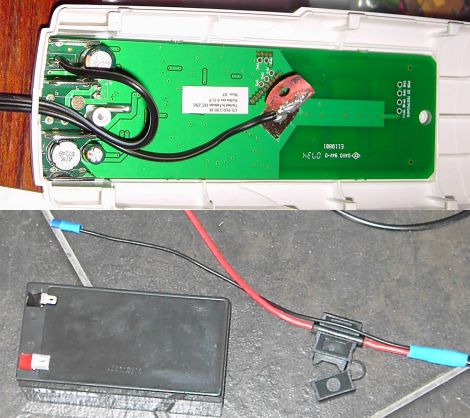
Living in a brushfire-prone area, [Erich] had a set of roller shutters installed to protect his home. Mains power can be spotty in emergencies, so the shutters are powered by NiMH batteries which are housed inside the shutters’ remote control units. After encountering a good handful of dead batteries, he decided it was time to search around for a better means of powering the shutters rather than pay another $80 AUD for batteries that he knew would fail in short order.
After disassembling the shutters and the remotes, he found a litany of problems. The remotes are ATMega-based, so he assumed the programming was robust, but he found that the charging algorithm was quite poorly implemented. The batteries were allowed to get extremely hot while charging, a result of the fact that charging was done for a set period of time rather than monitoring battery voltage. Additionally, the shutter motors required a 4 amp instantaneous current when activated, something that seemed to contribute to the quick draining of the 1500 mAH battery packs.
To remedy his issues, he upgraded to a much larger sealed lead acid battery pack, which he mounted in a wall cavity. The remotes were tweaked to add a modular power plug, enabling him to easily connect and disconnect the remotes as needed. Not only did he save a ton of money on constantly replacing batteries, he’s got a nice 12v power supply in the wall that he can tap into at will.















Very creative.
Although,
I’d have pause about concealing a battery
*behind* drywall.
Especially in a manner that renders it not
readily accessible.
Falls into the “Harry Homeowner” mods I’ve
seen over the years.
Granted this is Oz, so I’m not sure what the
building codes are over there. If it were my
house, i’d put the powersource in a case out
in the open (not stuffed into a wall cavity!).
erm… that’s BUSH fire not brush fire, you wouldn’t need protection for a brush fire – we eat brush fires for breakfast…
Why not mount the battery inside a large metal junction/breaker box/whatever those things are called?
As others mentioned, mounting it permanently in the wall is bad bad bad! What if the battery leaks?
Standard blank wall plates can be obtained that are bigger than the battery, and will allow easy access to the battery compartment. Clipsal is the Australian manufacturer for these wallplates, specifically, the “31/3VX” – “3 gang blank flush plate”.
I expect battery life with daily floating/top up cycles and fairly light duty to be at least 2-3 years, probably longer.
Cheers,
Erich.